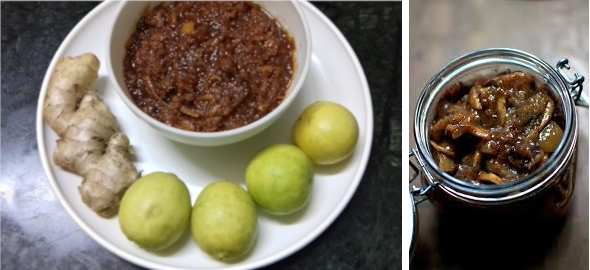Mama’s Punjabi Recipes: Nimbu aur Adrak da Achaar (LEMON & GINGER PICKLES)
 With summertime in full swing, it is the perfect season to make pickles especially, lemons – or limes – which are so plentiful and cheap now. Below is a reprint of Mama’s Nimbu aur Adrak da Achaar recipe. A little of this pickle can add a zest in otherwise bland food.
With summertime in full swing, it is the perfect season to make pickles especially, lemons – or limes – which are so plentiful and cheap now. Below is a reprint of Mama’s Nimbu aur Adrak da Achaar recipe. A little of this pickle can add a zest in otherwise bland food.
It is reprinted with some additional information and directions.
Adrak (ginger) is one of the main ingredients in Punjabi cooking, but it can also eaten by itself in pickle form or in the powdered form in spiced tea. Apart from its unique taste, ginger helps with the digestive process and reduces gas in the stomach. When used with black salt, ginger is used to help with nausea or to help cure the common cold.
Nimbu rus (lemon juice) is rich in vitamin C and is about 5% to 6% citric acid, with a pH of around 2.2, giving it a sour taste. Lemon juice contains slightly more citric acid than lime juice, nearly twice as much as in grapefruit juice, and about five times the amount of citric acid found in orange juice.
In the old days, and even now in villages in India, ginger would be peeled and then dried in the sun so that it could be used later when it was not easily available. Ginger is also peeled and made into a paste to use in the preparation of various meet dishes or to make some vegetarian dishes. But generally, it is cut into small pieces and used when preparing the base masala of dishes.
This is another really simple way to make an achaar (pickle) but in this, due to the spicy taste of the ginger you do not use any haldi (turmeric) or lal mirch (red pepper). When made with nimbus (lemons), it has a really summery feel.
If you prefer, you can add long, hari mircha in (green chilies) too: just wash, towel dry, score them with a slit and place them in the jar. In Texas, you can improvise by using jalapenos, either sliced or whole with slits. You can reduce the salt as you want in this achar. This achaar does not need to be refrigerated and keeps for a long time as long as it is kept in a cool room and not in the sunlight.
Ingredients:
1kg nimbu (lemons)
500 gm adrak (ginger root)
2 tablespoon namak (salt)
1 tablespoon of chinni (white sugar)
1 cup sirka (white vinegar)
Directions:
Wash the lemons, then towel dry them. Cut the lemons into four quarters. If the lemons are small, then cut into halves.
Peel the ginger root, then wash and also towel dry them. Cut the roots lengthwise in thin 2 inch long sticks.
Throw the ginger sticks and lemon halves into a glass jar and then add the salt.
Close the jar and shake well. Now add the vinegar and sugar, close the lid and shake well again.
Place the jar in the sun and shake the contents two or three times a day for a week.
The pickles will be ready to eat in 7 days and they will become tastier the longer they stay in the marinade. Be sure to shake the contents from time to time.
MAMA’S TIP OF THE WEEK: COOK PARANTHAS SLOWLY TO GET THAT TASTY CRISPY TEXTURE
People just love a Punjabi parantha, especially the ones stuffed with aloo (potatoes), mooli (radishes), gobi (cauliflower) and gajjar (carrots). They all taste good if they are cooked inside and out, don’t have burn spots on the outside and have a crispy top layer that can even be peeled back.
Unfortunately, these are the effects of cooking paranthas quickly over high heat and often they stay wet inside too, which is like eating half-cooked dough. In order to make crispy paranthas, have patience, cook them over medium slow heat and coat them with olive oil (or butter). You will see the results in the tasting!

Shakuntla Malhotra is a skilled cook of Punjabi dishes made in the old-fashioned style that she learnt as a young woman in her ancestral home in Lyallpur, India (since renamed Faisalabad) before it became part of Pakistan after the Partition in 1947. People have often admired her cooking for its simplicity and taste that comes with each mouthful. Even in her late-eighties, she continues to cook daily and agreed to share her delectable Punjabi recipes for future generations.
